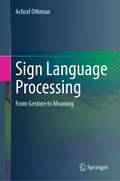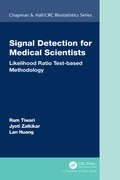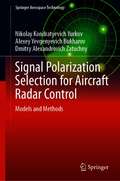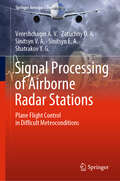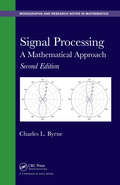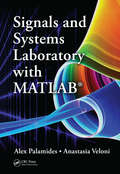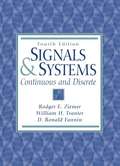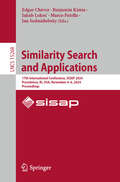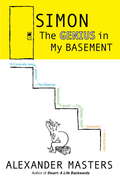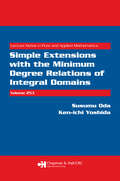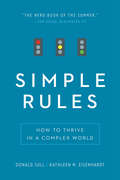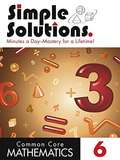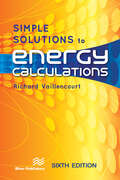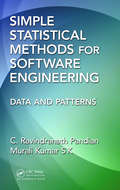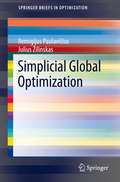- Table View
- List View
Sign Language Processing: From Gesture to Meaning
by Achraf OthmanIn a world where communication is key to human connection, understanding, and learning from one another, the book investigates the rich and intricate world of sign languages, highlighting the fascinating complexities of visual-spatial languages and their unique role in bridging the gap between hearing and deaf communities through information and communication technology. The book takes a journey through the evolution of sign language processing tools while exploring the cutting-edge techniques used to decipher, analyze, and process them, from the fundamentals of sign language structure and the nuances of non-manual signals to the latest developments in computational linguistics (corpora design, annotation tools, and notation systems), sign language recognition, and machine/deep learning applications. With a mission to reveal the silent language of expression, the author provides a captivating and thought-provoking look into a world often overlooked yet teeming with life and meaning. Offering a comprehensive and engaging overview of the current state of sign language research as well as its prospects, this monograph is an introduction resource for computer scientists, linguistics, educators, academics and sign language interpreters alike. This monograph is an invitation to discover the incredible potential of sign languages to transform human communication, promote inclusivity, and shape the future of technology. The readers will gain a deeper appreciation of the beauty and complexity of sign languages through technology, and they will be inspired to embrace the power of visual communication in our increasingly diverse and interconnected world.
Signal Detection for Medical Scientists: Likelihood Ratio Test-based Methodology (Chapman & Hall/CRC Biostatistics Series)
by Ram Tiwari Jyoti Zalkikar Lan HuangSignal Detection for Medical Scientists: Likelihood Ratio Based Test-Based Methodology presents the data mining techniques with focus on likelihood ratio test (LRT) based methods for signal detection. It emphasizes computational aspect of LRT methodology and is pertinent for first-time researchers and graduate students venturing into this interesting field. The book is written as a reference book for professionals in pharmaceutical industry, manufactures of medical devices, and regulatory agencies. The book deals with the signal detection in drug/device evaluation, which is important in the post-market evaluation of medical products, and in the pre-market signal detection during clinical trials for monitoring procedures. It should also appeal to academic researchers, and faculty members in mathematics, statistics, biostatistics, data science, pharmacology, engineering, epidemiology, and public health. Therefore, this book is well suited for both research and teaching. Key Features: Includes a balanced discussion of art of data structure, issues in signal detection, statistical methods and analytics, and implementation of the methods. Provides a comprehensive summary of the LRT methods for signal detection including the basic theory and extensions for varying datasets that may be large post-market data or pre-market clinical trial data. Contains details of scientific background, statistical methods, and associated algorithms that a reader can quickly master the materials and apply methods in the book on one’s own problems
Signal Polarization Selection for Aircraft Radar Control: Models and Methods (Springer Aerospace Technology)
by Dmitry Alexandrovich Zatuchny Nikolay Kondratyevich Yurkov Alexey Yevgenyevich BukharovThis book highlights the synthesis of polarization selection system in the background of passive noise formed by reflections from space-distributed targets. This synthesis is fulfilled as close as possible to its ideal configuration in terms of maximal signal-to-noise ratio for the matched load of radar station antenna system. It presents a new approach to radar system resolution enhancement based on the development of mathematical model for radiometric receivers with mono-pulse antenna systems, as well as creation of a new algorithm that allows increasing angular resolution during the object’s search and tracking due to special signal processing.
Signal Processing in Medicine and Biology: Applications of Deep Learning to the Health Sciences
by Joseph Picone Ammar AhmedSignal Processing in Medicine and Biology: Applications of Deep Learning to the Health Sciences presents expanded versions of selected papers from the 2023 IEEE Signal Processing in Medicine and Biology Symposium (IEEE SPMB) at Temple University. The symposium presents multidisciplinary research across a wide range of topics in the life sciences. The Neural Engineering Data Consortium hosts the symposium to promote machine learning and big data applications in bioengineering. Topics covered include: Signal and image analysis (e.g., EEG, ECG, MRI); Machine learning, data mining, and classification; Big data resources and applications; Applications of quantum computing; Digital pathology; Computational biology; Genomics, genetics, proteomics. Applications of particular interest at the 2023 symposium included digital pathology, computational biology, genomics, genetics, and proteomics. The book features tutorials and examples of successful applications that will appeal to many professionals and researchers in signal processing, medicine, and biology. For students and professionals new to the field, the book offers an easy-to-understand introduction to various bioengineering topics. For professionals active in the field, it provides essential algorithmic details on valuable benchmarks for the technology.
Signal Processing of Airborne Radar Stations: Plane Flight Control in Difficult Meteoconditions (Springer Aerospace Technology)
by Shatrakov Y.G. Vereshchagin A.V. Zatuchny D.A. Sinitsyn V.A. Sinitsyn E.A.This book highlights new methods and parametric algorithms for the digital coherent processing of signals in airborne radar systems located on air vehicles. Using the autoregressive (AR) model, it delivers more accurate danger assessments for flight in wind shear and atmospheric turbulence, while also suggesting how they could be implemented. Given its scope, the book is intended for technical experts whose work involves the development, production and operation of airborne radio-electronic systems.
Signal Processing: A Mathematical Approach, Second Edition (Chapman & Hall/CRC Monographs and Research Notes in Mathematics)
by Charles L. ByrneSignal Processing: A Mathematical Approach is designed to show how many of the mathematical tools the reader knows can be used to understand and employ signal processing techniques in an applied environment. Assuming an advanced undergraduate- or graduate-level understanding of mathematics-including familiarity with Fourier series, matrices, probab
Signals and Systems
by K. Deergha RaoThis textbook covers the fundamental theories of signals and systems analysis, while incorporating recent developments from integrated circuits technology into its examples. Starting with basic definitions in signal theory, the text explains the properties of continuous-time and discrete-time systems and their representation by differential equations and state space. From those tools, explanations for the processes of Fourier analysis, the Laplace transform, and the z-Transform provide new ways of experimenting with different kinds of time systems. The text also covers the separate classes of analog filters and their uses in signal processing applications. Intended for undergraduate electrical engineering students, chapter sections include exercise for review and practice for the systems concepts of each chapter. Along with exercises, the text includes MATLAB-based examples to allow readers to experiment with signals and systems code on their own. An online repository of the MATLAB code from this textbook can be found at github.com/springer-math/signals-and-systems.
Signals and Systems Laboratory with MATLAB
by Alex Palamides Anastasia VeloniDeveloped as a textbook for the laboratory part of the course Signals and Systems, this book introduces students to theory through analytical examples implemented in Matlab code. Thus every theoretical equation is accompanied by the corresponding code implementation. Instead of using big M-Files or author-written functions with comments, the commands are executed one-by-one at the Matlab command line and the results, dong with comments are given side-by side in two or three column tables. This is very helpful and popular to students in Electrical Engineering, since the nature of this course includes detailed mathematical derivations and demands a strong mathematical background.
Signals and Systems: Continuous and Discrete (4th Edition)
by Rodger E. Ziemer William H. Tranter D. Ronald FanninA market leader in previous editions, this book continues to offer a complete survey of continuous and discrete linear systems. It utilizes a systems approach to solving practical engineering problems, rather than using the framework of traditional circuit theory. Numerous examples from circuit theory appear throughout, however, to illustrate the various systems techniques introduced. The Fourth Edition has been thoroughly updated to effectively integrate the use of computers and to accurately reflect the latest theoretical advances.
Significant Figures: The Lives And Work Of Great Mathematicians
by Ian StewartA celebrated mathematician traces the history of math through the lives and work of twenty-five pioneering mathematiciansIn Significant Figures, acclaimed mathematician Ian Stewart introduces the visionaries of mathematics throughout history. Delving into the lives of twenty-five great mathematicians, Stewart examines the roles they played in creating, inventing, and discovering the mathematics we use today. Through these short biographies, we get acquainted with the history of mathematics from Archimedes to Benoit Mandelbrot, and learn about those too often left out of the cannon, such as Muhammad ibn Musa al-Khwarizmi (c. 780-850), the creator of algebra, and Augusta Ada King (1815-1852), Countess of Lovelace, the world's first computer programmer.Tracing the evolution of mathematics over the course of two millennia, Significant Figures will educate and delight aspiring mathematicians and experts alike.
Sikhs in the Deccan and North-East India
by Birinder Pal SinghThis book is a major intervention in the understanding of the dynamics of internal migration in South Asia. It traces the historical roots of certain migrant Sikh communities to the south and north-east India; chronicles their social, religious and economic practices; and examines peculiar identity formations. This first-of-its-kind empirical study examines the socio-economic conditions of Sikhs in the Deccan and the North-East who are believed to be the descendants of the soldiers in Maharaja Ranjit Singh’s army despatched to the two regions in the early nineteenth century. It draws on extensive ethnographic accounts to present the social realities of the different communities, including language, religion, culture, occupation, caste, marriage and kinship, and agency. It also questions the idea of Sikh homogeneity that many within the community have come to believe in, while revealing both differences and similarities. The book will be of great interest to scholars and researchers of sociology and social anthropology, migration and diaspora studies, religion, especially Sikh studies, cultural studies, as well as the Sikh diaspora worldwide.
Similarity Search and Applications: 17th International Conference, SISAP 2024, Providence, RI, USA, November 4–6, 2024, Proceedings (Lecture Notes in Computer Science #15268)
by Edgar Chávez Jakub Lokoč Marco Patella Benjamin Kimia Jan SedmidubskyThis book constitutes the refereed proceedings of the 17th International Conference on Similarity Search and Applications, SISAP 2024, held in Providence, RI, USA, during November 4–6, 2024. The 13 full papers, 7 short papers and 4 Indexing Challenge papers included in this book were carefully reviewed and selected from 32 submissions. They focus on efficient similarity search methods addressing the challenges of exploring similar items and managing vast machine-learning data sets efficiently.
Simon
by Alexander MastersAlexander Masters tripped over his first book subject on a Cambridge sidewalk, and the result was the multi-award-winning bestseller Stuart: A Life Backwards. His second, he's found under his floorboards. One of the greatest mathematical prodigies of the twentieth century, Simon Norton stomps around Alexander's basement in semidarkness, dodging between stalagmites of bus timetables and engorged plastic bags, eating tinned kippers stirred into packets of Bombay mix. Simon is exploring a theoretical puzzle so complex and critical to our understanding of the universe that it is known as the Monster. It looks like a sudoku table--except a sudoku table has nine columns of numbers. The Monster has 808017424794512875886459904961710757005754368000000000 columns. But that's not the whole story. What's inside the decaying sports bag he never lets out of his clutches? Why does he hurtle out of the house in the middle of the night? And--good God!--what is that noxious smell that creeps up the stairwell? Grumpy, poignant, comical--more intimate than either the author or his quarry intended--Simon: The Genius in My Basement is the story of a friendship and a pursuit. Part biography, part memoir, and part popular science, it is a study of the frailty of brilliance, the measures of happiness, and Britain's most uncooperative egghead eccentric.From the Hardcover edition.
Simple Extensions with the Minimum Degree Relations of Integral Domains (Lecture Notes in Pure and Applied Mathematics)
by Susumu Oda Ken-ichi YoshidaAlthough there are many types of ring extensions, simple extensions have yet to be thoroughly explored in one book. Covering an understudied aspect of commutative algebra, Simple Extensions with the Minimum Degree Relations of Integral Domains presents a comprehensive treatment of various simple extensions and their properties. In particular, it ex
Simple Rules: How to Thrive in a Complex World
by Kathleen M. Eisenhardt Donald SullHOW SIMPLICITY TRUMPS COMPLEXITY IN NATURE, BUSINESS, AND LIFE Complexity surrounds us. We have too much email, juggle multiple remotes, and hack through thickets of regulations from phone contracts to health plans. But complexity isn't destiny. Sull and Eisenhardt argue there's a better way. By developing a few simple yet effective rules, people can best even the most complex problems. In Simple Rules, Sull and Eisenhardt masterfully challenge how we think about complexity and offer a new lens on how to cope. They take us on a surprising tour of what simple rules are, where they come from, and why they work. The authors illustrate the six kinds o f rules that really matter - for helping artists find creativity and the Federal Reserve set interest rates, for keeping birds on track and Zipcar members organized, and for how insomniacs can sleep and mountain climbers stay safe. Drawing on rigorous research and riveting stories, the authors ingeniously find insights in unexpected places, from the way Tina Fey codified her experience at Saturday Night Live into rules for producing 30 Rock (rule five: never tell a crazy person he's crazy) to burglars' rules for robbery ("avoid houses with a car parked outside") to Japanese engineers mimicking the rules of slime molds to optimize Tokyo's rail system. The authors offer fresh information and practical tips on fixing old rules and learning new ones. Whether you're struggling with information overload, pursuing opportunities with limited resources, or just trying to change your bad habits, Simple Rules provides powerful insight into how and why simplicity tames complexity.
Simple Solutions Common Core Mathematics 2
by Diane Dillon Nancy Tondy Donna M. Mazzola Christopher Backs Nancy L. McGraw Lori LenderSimple Solutions Common Core Mathematics 6
by Nancy Tondy Donna M. Mazzola Christopher Backs Nancy L. McGrawSimple Solutions. Minutes a Day-Mastery for a Lifetime! Common Core Mathematics 6
Simple Solutions Minutes a Day--Mastery for a Lifetime: Algebra I, Part A, Mathematics
by Nancy L. McgrawThis workbook will give you the opportunity to practice skills you have learned in previous grades. By practicing these skills each day, you will gain confidence in your math ability. Using this workbook will help you understand math concepts easier and it will give you a more positive attitude toward math in general.
Simple Solutions to Energy Calculations
by Richard VaillencourtUpdated with new material, this book shares the author’s secrets for simplifying complex energy calculations, and shows you how to use these time-saving methods. It shows you how to cut through the maze using innovative decision-making tools to determine whether you should invest real time and money for developing details of a project being considered. There is information covered on simplified thermodynamics that gives you a blueprint for controlling the building’s energy consumption. Key topics covered include the walk-through audit, pumps & fans VFD, high efficiency motors, insulation, fuel switching, heat recovery, HVAC, air compressor, "energy myths and magic". Each chapter has "Richard’s Retrofit Rules" and anecdotal experience in the retrofit. There is a summary of energy calculations given by category, plus a discussion of performance guarantees that helps a building manager decide which ESCO can best deliver on their promises of energy savings.
Simple Solutions, Common Core Mathematics 5
by Nancy Tondy Donna M. Mazzola Nancy L. McGrawNIMAC-sourced textbook
Simple Solutions: Common Core Mathematics 3
by Nancy L. Mcgraw Nancy Tondy Donna M. Mazzola Christopher BacksMathematics Workbook for Third Grade
Simple Statistical Methods for Software Engineering: Data and Patterns
by C. Ravindranath Pandian Murali KumarAlthough there are countless books on statistics, few are dedicated to the application of statistical methods to software engineering. Simple Statistical Methods for Software Engineering: Data and Patterns fills that void. Instead of delving into overly complex statistics, the book details simpler solutions that are just as effective and connect wi
Simple Statistical Tests for Geography
by Danny McCarrollThis book is aimed directly at students of geography, particularly those who lack confidence in manipulating numbers. The aim is not to teach the mathematics behind statistical tests, but to focus on the logic, so that students can choose the most appropriate tests, apply them in the most convenient way and make sense of the results. Introductory chapters explain how to use statistical methods and then the tests are arranged according to the type of data that they require. Diagrams are used to guide students toward the most appropriate tests. The focus is on nonparametric methods that make very few assumptions and are appropriate for the kinds of data that many students will collect. Parametric methods, including Student’s t-tests, correlation and regression are also covered. Although aimed directly at geography students at senior undergraduate and graduate level, this book provides an accessible introduction to a wide range of statistical methods and will be of value to students and researchers in allied disciplines including Earth and environmental science, and the social sciences.
Simple Statistics: Applications in Social Research
by Terance D. Miethe Jane Florence GauthierThe efficient use of statistics can transform excellent research into dynamic, persuasive scholarship. To demystify the process of calculating data, Simple Statistics: Applications in Social Research provides a concise introduction to basic social statistics.
Simplicial Global Optimization
by Remigijus Paulavičius Julius ŽilinskasSimplicial Global Optimization is centered on deterministic covering methods partitioning feasible region by simplices. This book looks into the advantages of simplicial partitioning in global optimization through applications where the search space may be significantly reduced while taking into account symmetries of the objective function by setting linear inequality constraints that are managed by initial partitioning. The authors provide an extensive experimental investigation and illustrates the impact of various bounds, types of subdivision, strategies of candidate selection on the performance of algorithms. A comparison of various Lipschitz bounds over simplices and an extension of Lipschitz global optimization with-out the Lipschitz constant to the case of simplicial partitioning is also depicted in this text. Applications benefiting from simplicial partitioning are examined in detail such as nonlinear least squares regression and pile placement optimization in grillage-type foundations. Researchers and engineers will benefit from simplicial partitioning algorithms such as Lipschitz branch and bound, Lipschitz optimization without the Lipschitz constant, heuristic partitioning presented. This book will leave readers inspired to develop simplicial versions of other algorithms for global optimization and even use other non-rectangular partitions for special applications.
